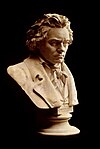Symphony No. 2 (Beethoven)
Ludwig van Beethoven's Symphony Number 2 in D Major, Opus 36 was written between 1801 and 1802 and is 36 minutes long. It is dedicated to Prince Lichnowsky.
This symphony consists of four movements:
- Adagio molto -- Allegro con brio
- Larghetto
- Scherzo: Allegro
- Allegro molto
The work was premiered in the Theater an der Wien in Vienna on April 5, 1803, and was conducted by the composer. It is one of the last works of Beethoven's so-called "early period".
Background, composition and reception
Beethoven's Second Symphony was mostly written during Beethoven's stay at Heiligenstadt in 1802, which was near the time that he began to realize he was becoming deaf. Beethoven wrote the Second Symphony without having a standard Minuet; a Scherzo took its place, which gave the composition an even greater scope and energy. After the symphony's premiere, critics noted the absence of the traditional Minuet, and claimed the composition had great strength, but was altogether too eccentric.
Analysis of 1st movement
The introduction (Adagio molto) begins in D major, changing to B♭ major in measure 11. In measures 26-28, he briefly modulates to A major and immediately back to D.
The exposition (Allegro con brio) begins in D major with the A theme lasting until measure 57. A transition towards the B theme lasts until measure 72, modulating to A minor at measure 61. The B theme begins in A major at 73, moving to A minor again at 113 with a codetta from measure 117-136 (moving to D major in measure 120).
The development uses material from the A theme, going through several modulations throughout and making use of the main idea from Theme A in sequence.
At measure 216, the A theme returns in the recapitulation, lasting until measure 228. There is a retransition from 229-244, bringing back the B theme at measure 245, this time in the tonic key. At 327, B♭ major returns briefly, moving back to D in 334 with a Coda from measures 340-360.
External links
- Analysis of Beethoven Symphony No.2 on the All About Ludwig van Beethoven Page

